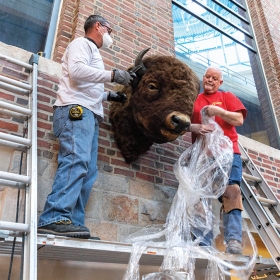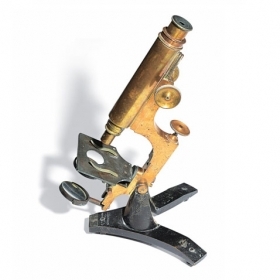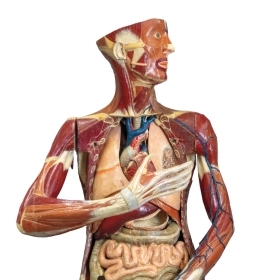Reports From Around Campus

Heads Up
Before the Science Complex renovation began, John Cameron, professor emeritus of biological sciences, cataloged some 1,600 objects that had been used in labs or displayed in the old Science Center—from giant papier-mâché flowers to 1870s-vintage brass microscopes. This spring, one of those objects reappeared when the head of an American bison (scientific name Bison bison) was reinstalled in a place of honor in the Faroll Focus. The taxidermy head first peered down at students in 1934. It was a gift from the estate of Henry Sweet of Dover, Mass., a photographer who accompanied a number of important archaeological expeditions and was a good friend of Wellesley trustee—and Massachusetts governor—William Claflin. “There were always stories about the bison head having been stolen from the wall as a prank,” Cameron says. “Supposedly it spent several years in an MIT frat house in the ’80s.” Now, once again, it’s home.
A Wellesley Farewell
With personal tributes from colleagues at Academic Council and recognition at commencement, Wellesley noted the long and distinguished careers of 10 faculty members retiring this year, celebrating their decades of teaching, mentorship, and innovative research. They are: Barbara Beltz, Allene Lummis Russell Professor of Neuroscience, 1987–2023; Robbie Berg, professor of physics, 1985–2023; Sharon Elkins, professor of religion, 1976–2023; Alice Friedman, Grace Slack McNeil Professor of American Art, 1979–2022; Nancy Abraham Hall, senior lecturer in Spanish, 1989–2023; Kenneth Hawes, senior lecturer in education, 1986–2023; Jean Herbst, senior instructor in computer science laboratory, 1993–2022; Jessica Polito, lecturer in the quantitative reasoning program, 2000–2022; Nancy Scherer, associate professor of political science, 2006–2023; and David Ward, professor of Italian studies, 1989–2023.
By the Numbers Source: Data gathered by students in ES 300: Environmental Decision-Making, who assessed the College’s waste management systems. Click here to read the full report.
“Sorry I missed your call—I was at Stepsinging. I’m hitting all the Wellesley traditions.”
Total tons of waste produced by the College annually (plastic, metal, paper, glass, cardboard, food scraps)
Tons of waste produced by the residence halls
Tons of waste produced by the academic buildings
Tons of waste produced by the dining halls
Percent of waste that could be diverted from the trash stream to recycling or anaerobic digestion


